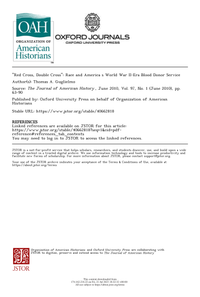Thomas Guglielmo reports that the American Red Cross continued racial segregation of blood until 1950.
- Type
- Academic / Technical Report
- Source
- Thomas Guglielmo Non-LDS
- Hearsay
- DirectReprintSecondary
- Reference
G. Canby Robinson, "Confidential Policy Statement concerning Volunteer Negro Blood Donors," November 5, 1941, box 909, National Archives Gift Collection, in Thomas Guglielmo, "'White Cross, Double Cross': Race and America's World War II-Era Blood Donor Service," Journal of American History (June 2010): 82
- Scribe/Publisher
- Journal of American History
- People
- Thomas Guglielmo, New York Times, American Red Cross
- Audience
- James J. McCloy, Reading Public
- Transcription
In the end, real change to blood segregation policies came only after the war. In June 1947 the Red Cross published a new statement that made minor concessions to civil rights activists: "Inasmuch as, on the basis of recorded scientific and medical opinion, there is no difference in the blood of humans based upon race or color, the [national donor] plan does not require the segregation of blood; however, whenever necessary to insure the success of the plan . . . chapters will collect and hold blood in such a manner as to give the physician and the patient the right of selection at the time of administration." Not until 1950 did Red Cross leadership finally vote to discontinue marking racial designations on the official medical records of blood donors. Hailing the decision, the New York Times announced: "human blood is human blood regardless of the degree of pigmentation in the skin."
The B. H. Roberts Foundation is not owned by, operated by, or affiliated with the Church of Jesus Christ of Latter-day Saints.

